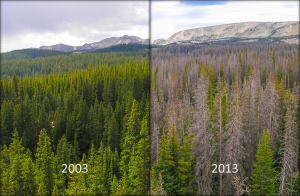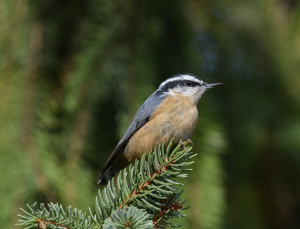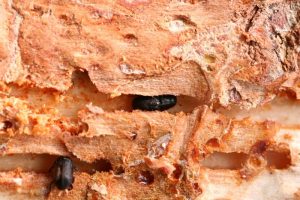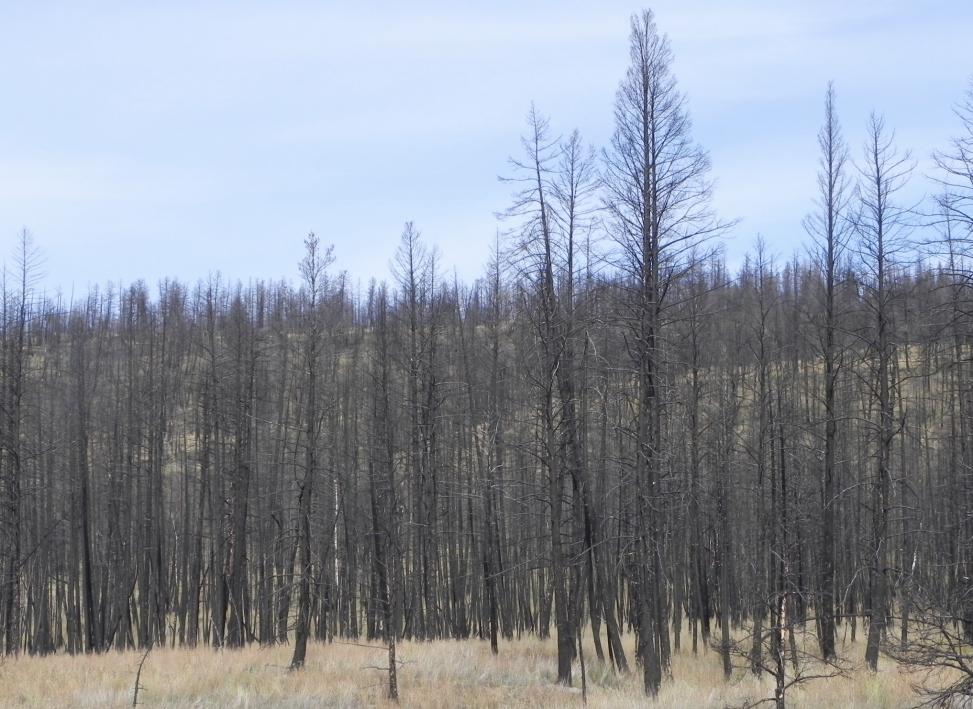By Jordan Haber
What’s the Buzz?
25 February 2020
According to a recent 2019 study by researchers at Montana State University and the University of Vermont, growing populations of pine beetles are resulting in increased death of pine, spruce, and fir, which are impacting song bird populations. The researchers, which include mostly biologists and ornithologists, say climate change is likely to blame for the increased beetle populations and predict the epidemic will continue to intensify.
The study observed bird populations in four forest sites in the Northern Elkhorn Mountains near Helena, Montana. Researchers observed populations of 39 forest bird species from pre-epidemic years (2003-2006) to post-epidemic years (2009-2011). During the epidemic, some 80% of dominant mature pine species were impacted by the Mountain Pine Beetle (MPB) (Dendroctonus ponderosae).

MPB progression in a Ponderosa pine forest in neighboring north central Wyoming (photo credit John Frank).
The prominent tree species being impacted by MPB include the ponderosa (Pinus ponderosa) and the Lodgepole pines (Pinus contorta). The Ponderosa Pine is particularly important for forest birds, which rely on the tree for food and nesting material. Thus, it’s no surprise that declines in the population of pine seed consuming and cavity nesting birds were observed.
More surprisingly however, was the number of forest bird species that were actually increasing in population as a result of the epidemic. At least five species of birds, including the Dark-eyed Junco, Pine Siskin, Chipping Sparrow, Red-breasted Nuthatch, and Yellow-rumped Warbler, occurred in greater numbers post MPB epidemic then before. Researchers believe the main reason is an increase in food resulting from higher MPB populations and an increase in nesting sites for species who prefer to roost in snags or standing dead trees.

While many forest birds are declining, the Red-breasted Nuthatch was found to be more abundant in post MPB epidemic forests. The Red-breasted Nuthatch dines on the plentiful MPBs and nests in the hollowed out cavities of dead pine snags that the beetles leave behind.
Despite the glimmer of hope for certain forest bird species, forest ecologists warn that as the climate continues too warm and MPB epidemics continue to intensify, pine forest communities may fail to exist all together. Such catastrophic predictions, would likely spell doom for most forest bird species.
Pine beetles have been a native component to pine forests for as long as people started paying attention to them, but they have “never existed in the numbers that they do today” says Diana Six a professor of forest entomology and pathology at the university of Montana. The problem started to emerge when federal and state governments instructed rangers to limit fire suppression in pine dominated forests.
The fires would typically act as a control on beetle populations in addition to killing off older weaker trees. The fires also play a role in pine reproduction. The pinecones of many coniferous tree species will not release their seeds unless heated to 270°F, and thus forest fires play a vital role in seed dispersal.
In these fire deprived forests, older trees mature and die with fewer healthier, younger trees competing to take their place. Under these conditions the MPBs underwent an explosion of growth.
According to officials from the U.S Forest Service, “climate change is exasperating the situation”. Historically, cold winters would kill off portions of the beetle’s eggs that are left to over winter. Recently however, the winters have been getting warmer, and greater numbers of beetle eggs and larvae are surviving to Spring.

MPBs dig burrows into trees where they lay their eggs and disrupt the ability of the tree to circulate water and essential nutrients.
As MPBs continue to eat their way through North America’s pine forests, forest bird species that rely on the pine for their life cycles are being displaced. Going forward, more research will need to be conducted into the long-term impacts of MPBs and forest bird communities. Hopefully, such research can be used to better manage forests and protect those species and ecosystems that are most at risk from the MPB epidemic.
References:
Mosher, A. B., Saab, V. A., Lerch, D. M., Ellis, M. M., and Rotella, J. J. 2019. Forest birds exhibit variable changes in occurrence during a mountain pine beetle epidemic. Ecosphere 02935.

Alex
"This title was very eye catching! That is so interesting that such a ..."
Alex
"This is really interesting! The fact that crops and plants are damaged is ..."
Alex
"Well done, this article is great and the information is very captivating! Ethics ..."
Alex
"I was intrigued throughout the whole article! This is such an interesting topic, ..."
Alex
"This is such an interesting article, and very relevant!! Great job at explaining ..."
Grandpa
"Honey You Did a good job I will forward to my eye doctor "
murphymv
"This article is fascinating because it delves into the details of the research ..."
murphymv
"I agree, adding the photo helped solidify the main finding. "
murphymv
"This is a fascinating finding. I hope this innovative approach to improving transplants ..."
Sherzilla
"This is a great article! I would really love to hear how exactly ..."
Sherzilla
"It's disappointment that these treatments were not very effective but hopefully other researchers ..."
Sherzilla
"I agree with your idea that we need to shift our focus to ..."
Sherzilla
"It's amazing to see how such an everyday household product such as ..."
Lauren Kageler
"I will be interested to see what the data looks like from the ..."
Lauren Kageler
"A very interesting article that emphasizes one of the many benefits that the ..."
maricha
"Great post! I had known about the plight of Little Browns, but I ..."
Sherzilla
"I assumed cancer patients were more at risk to the virus but I ..."
Sherzilla
"Great article! It sheds light on a topic that everyone is curious about. ..."
maricha
"This article is full of really important and relevant information! I really liked ..."
maricha
"Definitely a very newsworthy article! Nice job explaining the structure of the virus ..."
maricha
"It's interesting to think that humans aren't only species dealing with the global ..."
murphymv
"This is very interesting and well explained. I am not too familiar with ..."
Lauren Kageler
"Great article! This post is sure to be a useful resource for any ..."
Lauren Kageler
"Definitely seems like an odd pairing at first, but any step forward in ..."
murphymv
"What an interesting article! As you say, height and dementia seem unrelated at ..."
murphymv
"Great article! I learned several new methods of wildlife tracking. This seems like ..."
murphymv
"Very interesting topic! You explained cascade testing and its importance very well. I ..."
Alex
"This article is really interesting! What got me hooked right away was the ..."
Sabrina
"I found this article super interesting! It’s crazy how everyday products can cause ..."
Erin Heeschen
"I love the layout of this article; it's very eyecatching! The advancements of prosthetics ..."
murphymv
"Awesome article! I like the personality in the writing. Flash Graphene not only ..."
murphymv
"Very interesting work! I don't know a whole lot about genetics, but this ..."
Cami Meckley
"I think the idea of using virtual reality technology to better help prepare ..."
Erin Heeschen
"I wonder if there's a connection between tourist season and wildfires in the ..."
Ralph berezan
"Not bad Good work "
Michelle
"This sounds like it would be a great tool for medical students! ..."